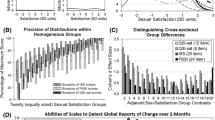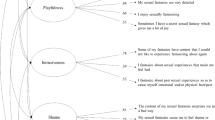Abstract
A psychometric analysis of the Sexual Experience Scale (SES) from the Derogatis Sexual Functioning Inventory was conducted. This sexual behavior measure was administered on four occasions to a large sample of normal, heterosexual, sexually active women and a comparable sample which underwent gynecologic treatment that resulted in a predictable and clinical level of sexual dysfunction. In terms of reliability, internal consistency estimates for the SES were in the .85 to .90 range, but the stability of the SES was lower and ranged from .55 to .85. An evaluation of the validity revealed both strengths and limitations of the SES. The content analysis reveals that a wider range of sexual behaviors is sampled by the SES than comparable measures. To examine construct validity, a factor analysis provided a five-factor solution which would account for 82% of the variance, but the solution was not stable across groups or time and the factors were not sensitive to detecting important behavior changes. As many other psychological measures, the SES was poor in predicting a criterion (i.e., the occurrence of sexual dysfunction) concurrently or at the time of follow-up. The outcome of this analysis is discussed in the context of selecting reliable and valid self-report measures of sexual behavior.
Similar content being viewed by others
References
American Psychiatric Association. (1980).Diagnostic and Statistical Manual of Mental Disorders 3rd ed., APA, Washington, DC.
Andersen, B. L. (1981). A comparison of systematic desensitization and directed masturbation in the treatment of primary orgasmic dysfunction in females.J. Consult. Clin. Psychol. 49: 568–570.
Andersen, B. L. (1983). Primary orgasmic dysfunction: Diagnostic considerations and review of treatment.Psychol. Bull. 93: 105–136.
Andersen, B. L. (1985). Sexual functioning morbidity among cancer survivors: Present status and future research directions.Cancer 55: 1835–1842.
Andersen, B. L. (1987a). Conceptualization, assessment and research design: Study of sexual functioning among cancer patients.
Andersen, B. L. (1987b). Sexual functioning complications in women with gynecologic cancer: Outcomes and directions for prevention.Cancer 60: 2123–2128.
Andersen, B. L., Anderson, B., and deProsse, C. (in press). Controlled prospective longitudinal study of women with cancer: I. Sexual functioning outcomes.J. Consult. Clin. Psychol.
Andersen, B. L., and Hacker, N. F. (1983). Treatment for gynecologic cancer: A review of the effects on female sexuality.Health Psychol. 2: 203–221.
Andersen, B. L., Lachenbruch, P. A., Anderson, B., and deProsse, C. (1986). Sexual dysfunction and signs of gynecologic cancer.Cancer 57: 1880–1886.
Bentler, P. M. (1968a). Heterosexual behavior assessment: I. Males.Behav. Res. Ther. 6: 21–25.
Bentler, P. M. (1968b). Heterosexual behavior assessment: II. Females.Behav. Res. Ther. 6: 27–30.
Brady, J. P., and Levitt, E. E. (1965). The relationship of sexual preferences to sexual experience.Psychol. Rec. 15: 377–384.
Cronbach, L. J., and Meehl, P. E. (1955). Construct validity in psychological tests.Psychol. Bull. 52: 281–302.
Dennerstein, L., and Burrows, G. D. (1982). Hormone replacement therapy and sexuality in women.Clin. Endocrinol. Metab. 11: 661–679.
Derogatis, L. B., and Melisaratos, N. (1979). The DSFI: A multidimensional measure of sexual functioning.J. Sex Marital Ther. 5: 244–281.
Halstrom, T. (1977). Sexuality in the climacteric. In Greenblatt, R. B., Studd, J. J., and Eastbourne, J. (eds.),Clinical Obstetrics and Gynecology W. B. Saunders, Philadelphia, pp. 277–239.
Harmon, H. A. (1976).Modern Factor Analysis The Unitersity of Chicago Press, Chicago.
Hite, S. (1976).The Hite Report MacMillan, New York.
Holcomb, W. R., Adams, N. A., and Donder, H. M. (1983). Factor structure of the Symptom Checklist-90 with acute psychiatric inpatients.J. Consult. Clin. Psychol. 51:535–538.
Karoly, P. (ed.). (1985).Measurement Strategies in Health Psychology Wiley, New York.
Kinsey, A. C., Pomroy, W. B., and Martin, C. E. (1948).Sexual Behavior in the Human Male W. B. Saunders, Philadelphia.
Kinsey, A. C., Pomroy, W. B., Martin, C. E., and Gebhard, P. H. (1953).Sexual Behavior in the Human Female W. B. Saunders, Philadelphia.
Korff, J., and Geer, J. H. (1983). The relationship between sexual arousal experience and genital response.Psychophysiology 20: 121–127.
LoPiccolo, J., Heiman, J. R., Hogan, D. R., and Roberts, C. W. (1985). Effectiveness of single therapists versus cotherapy teams in sex therapy.J. Consult. Clin. Psychol. 53: 287–294.
Maguire, G. P., Lee, E. G., Bevington, D. J., Kuchemann, C. S., Crabtree, R. J., and Cornell, C. E. (1978). Psychiatric problems in the first year after mastectomy.Br. Med. J. 1: 963–965.
Masters, W. H., and Johnson, V. E. (1970).Human Sexual Inadequacy Little, Brown, Boston.
Morris, T., Greer, H. S., and White, P. (1977). Psychological and social adjustment to mastectomy: A two-year follow-up study.Cancer 40: 2381–2387.
Pearson, K. (1901). Mathematical contributions to the theory of evolution, VII: On the correlation of characters not quantitatively measurable.Philos. Trans. R. Soc. Lond. [Math. Phys. Sci.] 195: 1–47.
Podell, L., and Perkins, J. C. (1957). A Guttman Scale for sexual experience: A methodological note.J. Abn. Soc. Psychol. 54: 420–422.
Sabalis, R. F. (1983). Assessing outcome in patients with sexual dysfunctions and sexual disorders. In Lambert, M. J., Christensen, E. R., and DeJulio, S. S. (eds.),The Assessment of Psychotherapy Outcome John Wiley & Sons, New York, pp. 205–262.
Terman, L. M. (1938).Psychological Factors in Marital Happiness McGraw-Hill, New York.
Vincent, C. E., Vincent, B., Greiss, F. C., and Linton, E. B. (1975). Some marital-sexual concomitants of carcinoma of the cervix.South. Med. J. 68: 522–558.
Author information
Authors and Affiliations
Additional information
The research was supported by Grant NIRA 1 R23 CA35702-01A1 from the National Cancer Institute.
Rights and permissions
About this article
Cite this article
Andersen, B.L., Broffitt, B. Is there a reliable and valid self-report measure of sexual behavior?. Arch Sex Behav 17, 509–525 (1988). https://doi.org/10.1007/BF01542339
Issue Date:
DOI: https://doi.org/10.1007/BF01542339




